Media library
Documentary, graphic and/or audiovisual knowledge objects are offered here, offering information on various sectors and topics. Use the keyword search or search filters to access current audiovisual and documentary knowledge objects useful for your implementation.
If you have any questions or suggestions, please contact us here.
Contingency plan for suspected and confirmed sheep and goat pox in Andalusia
Sheep and goat pox is an infectious disease caused by a DNA virus belonging to the Capripoxvirus genus within the Poxviridae family. It produces a clinical picture in sheep and goats characterized by the appearance of fever, generalized nodules and papules, rarely vesicles, internal lesions particularly in the lungs, and, ultimately, death.
Manual on national plans for the eradication of animal diseases in Andalusia
Manual for the eradication of ruminant diseases
Caprine tuberculosis control program
Tuberculosis is a chronic, contagious, infectious disease that suppresses the immune system, leading to the onset of other illnesses, loss of production, and trade restrictions, including restrictions on participation in auctions and competitions. It affects all domestic animals, some wild animals, and humans, and is therefore classified as a zoonosis.
National Bovine Tuberculosis Eradication Program in Andalusia
The territorial scope of this program is the Autonomous Community of Andalusia, which, according to the national program, is included among those autonomous communities with a herd prevalence rate greater than 1% or "high prevalence."
Results of surveillance of transmissible spongiform encephalopathies
Bovine spongiform encephalopathy (BSE, colloquially known as "mad cow disease") is one of the transmissible spongiform encephalopathies (TSE) that affects cattle. Like other TSE diseases, it is characterized by the degeneration of brain tissue, which takes on a sponge-like appearance, leading to death.
National Program for Surveillance and Control of Bovine Brucellosis in Andalusia.
Member States are primarily responsible for the eradication of bovine brucellosis. Therefore, the main objective is to declare regions or provinces officially free of bovine brucellosis by Community Decision if they meet the criteria established in Delegated Regulation (EU) 2020/689, consisting of the absence of confirmed cases of B. abortus, B. melitensis, or B.
National Program for Surveillance and Control of Ovine and Goat Brucellosis in Andalusia.
Member States are primarily responsible for the eradication of ovine and caprine brucellosis. Therefore, the main objective is to declare regions or provinces officially free of brucellosis by Community Decision if they meet the criteria established in Delegated Regulation (EU) 2020/689, consisting of the absence of confirmed cases of B. abortus, B. melitensis, or B.
National Program for Surveillance and Control of Ovine and Goat Brucellosis 2023-2030. (Infection with B. abortus, B. melitensis, and B. suis)
Member States are primarily responsible for the eradication of ovine and caprine brucellosis. For a zone to be declared officially free from the disease, it must meet the following requirements: no confirmed cases of B. abortus, B. melitensis, or B.
National Bovine Tuberculosis Eradication Program (Mycobacterium tuberculosis complex infection)
Tuberculosis is an infection by any of the mycobacterial species of the Mycobacterium tuberculosis complex (MTC) present in bovine animals (including all Bos and Bubalus species) and in bison (Bison bison and Bison bonasus), in deer, goats or camelids.
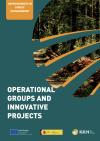
Livestock Breeding. Operational Groups And Innovative Projects
English translation of a compilation of projects developed through the regional and national Rural Development Programmes, operational groups and innovative projects that are working on livestock breeding.
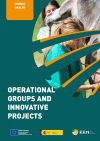
Animal Health. Operational Groups And Innovative Projects
English translation of a compilation of projects developed through regional and national Rural Development Programmes, operational groups and innovative projects that are working on animal health issues.
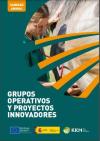
Animal Health. Operational Groups and Innovative Projects
This publication is a compilation of Operational Groups and Innovative Projects in animal health in Spain.
Dossier of supra-autonomous innovation projects
Inventory of innovative projects implemented by supra-regional operational groups of the European Innovation Partnership for agricultural productivity and sustainability of the National Rural Development Programme (PNDR) 2014-2022, submeasure 16.2.
Grups operatius a Catalunya. Call 2018 (Catalan)
The Technical Dossier no. 123: “Grups operatius a Catalunya. Call 2018” is dedicated to the Groups Operatius developed within the framework of the CAP Strategic Plan (PEPAC 2023-2027), and includes the Agricultural Knowledge and Innovation Systems, also linked to AKIS (Agricultural Knowledge and Innovation System).
Operational Groups in Catalonia. Call for 2018
"Technical Dossier No. 123: “Operational groups in Catalonia. Call 2018” is dedicated to the Operational Groups developed within the framework of the CAP Strategic Plan (PEPAC 2023-2027), and taking into account the Agricultural Knowledge and Innovation Systems, also known as AKIS (Agricultural Knowledge and Innovation System).
Report on Spanish supra-autonomous EIP-AGRI projects 2017-2022
The report summarizes the first funding period (2014-2022) of the European Innovation Partnership for Agricultural Productivity and Sustainability (EIP-Agri) operational groups, implemented at supra-autonomous level in Spain.
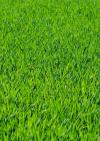
Study on the beef sector in Spain. Calf fattening. SITRAN 2021 data
Analysis of the basic aspects of the productive activity dedicated to calf fattening in Spain as well as its evolution in recent years through the analysis of the information contained in the SITRAN database.

GO VACUSOS, Increasing the economic sustainability of cattle fattening on extensive farms with suckler cows.
Increasing the economic sustainability of extensive cattle fattening on extensive suckler cow farms.
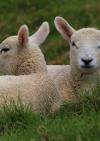
GO OVINNOVA. "An innovative business model for transhumance, an ancient and necessary practice."
Design of a business model for the provision of livestock services to improve the competitiveness of transhumant grazing, essential for the conservation of biodiversity and the sustainable management of the “pasture” resource.




